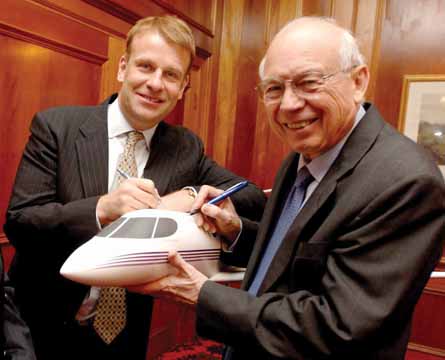Charles Williams reports on the SJ30's 20-year journey to EBACE 2006
It has been a 20-year road to EBACE for Sino Swearingen’s SJ30 light jet, which achieved US Federal Aviation Administration certification in October last year.
“I started working on the concept in 1986. There’s no logical reason for it taking that long,” admits Ed Swearingen, the company’s founder and the brains behind the aircraft.
The SJ30’s protracted development cycle has had its fair share of setbacks, from delays securing funding to the fatal crash of a production prototype in May 2003.
 Ed Swearingen (right) with Hamish Harding, chairman of Action Aviation |
Now, however, the hurdle of FAA type certification is behind it and icing and interior configuration certifications were received in April. European Aviation Safety Agency approval is expected in the first quarter of 2007.
Swearingen, a veteran of the aviation industry and able to relate stories that include names like Bill Lear and Dee Howard, says the reasons he initially wanted to build the SJ30 still stand up in 2006.
“I believe the turboprop industry produced the best market in aviation,” he says. “But none of those buyers really wanted turboprops. They were people who couldn’t afford jets, but wanted the characteristics of them. The SJ30 is a replacement for the turboprop market – it’s similar in cost and has the advantage of being a real jet airplane.”
Faster, farther and higherAn aircraft that promises to deliver you “faster, farther, higher” than any other in its class, Sino Swearingen’s SJ30-2 light jet has a high-speed cruise of 0.83 Mach (486kt/900km/h). It is powered by two Williams FJ44-2A engines, each offering 2,300lb of thrust (10kN). |
|
This activity, as the SJ30 takes its final steps towards being commercially available, is the result of more than half a billion dollars total investment, from the first idea to now, Swearingen estimates.
“We spent 10-15% of that designing and building the first aircraft and a good share of it in search of capital. Our Taiwanese partners, who came in in 1995, have been steadfast – they have spent a lot more money than they planned to in the beginning.”
Behind the SJ30’s design are some important basic concepts. Swearingen came up with the general idea for the jet after undertaking a detailed study of corporate and airline aircraft.
“I learned that the worldwide airline fleet is 43% more efficient than the corporate fleet. This was a shock to me,” he says. “I thought they were all the same, just a different size. But companies like Airbus and Boeing have a level of technology not available in the general aviation industry. I thought I should put some effort into figuring out how they did it and this aircraft is the result of that.”
Using more efficient, smaller engines and building a high-speed wing without compromising it are just two of the features Swearingen cites as differentiators between the SJ30 and other light jets on the market.
“People are still building airplanes with low-speed wings,” he says. “Frankly, they’re turboprops that just have jet engines on them.”
Swearingen is hopeful that the SJ30, so named as it is his thirtieth aircraft design, will not represent his swansong in the industry.
“The transportation industry as a whole has major things available in it that are not being done,” he says, “in terms of more advanced products that can do a better job for less money. I’d like to be a part of making that happen.”
He adds: “I regret people are building aircraft that aren’t as efficient as they could be. They don’t cost more if they’re more efficient, they’re just shaped differently.”
Source: Flight Daily News



















